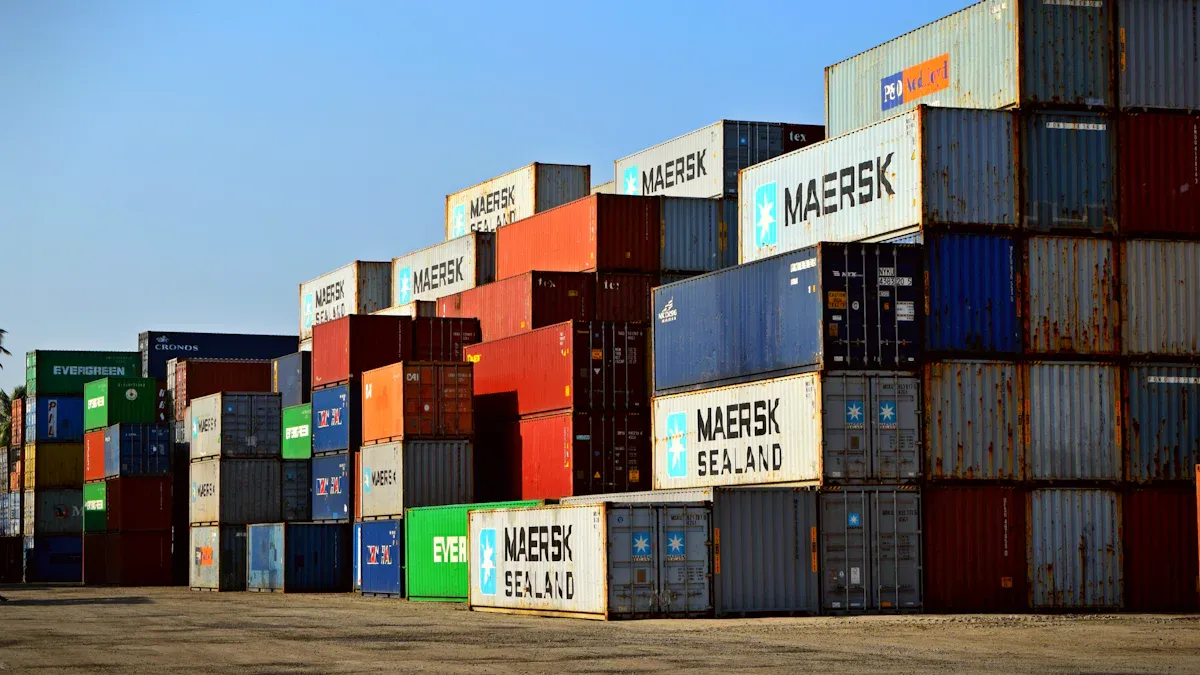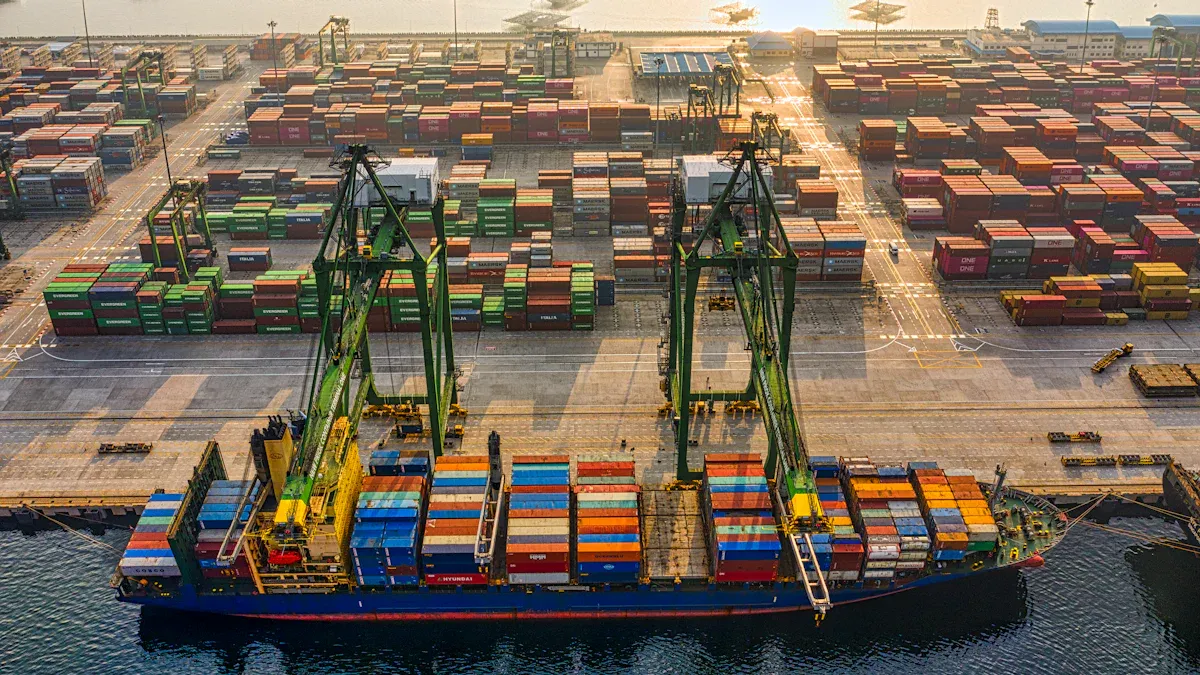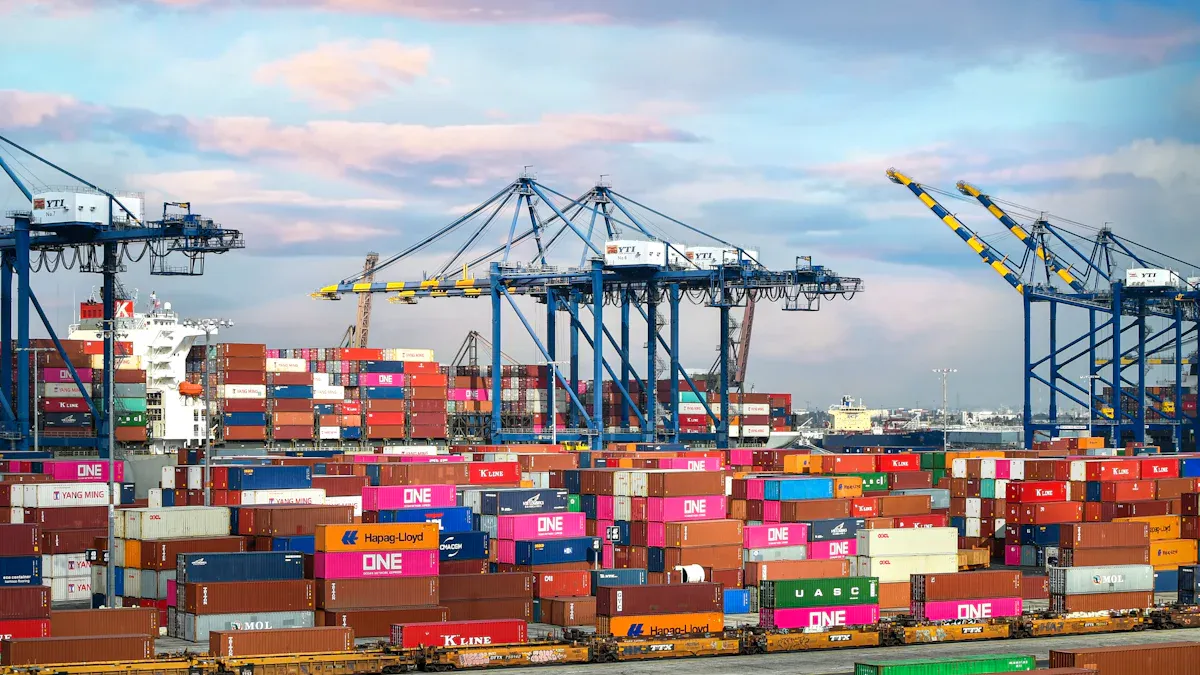Supply Chain and Logistics Comparison for Modern Businesses

Supply chain management involves coordinating all stages required to produce and deliver a product, from sourcing materials to ensuring the final product reaches customers. Logistics, on the other hand, focuses on the movement, storage, and handling of goods within this system. The difference between the supply chains lies in their scope—supply chain management oversees the entire process, while logistics zeroes in on specific operational tasks.
The benefits are significant: effective strategies can lead to a 15-30% reduction in inventory costs and a 20-50% improvement in order delivery. By refining these processes, businesses operate more efficiently, reduce expenses, and enhance customer satisfaction.
Key Takeaways
Know the difference: Supply chain handles everything, logistics moves and stores goods.
Use technology: Tools like AI and blockchain make work faster and cheaper.
Work together: Good teamwork with suppliers and shippers makes customers happy.
Improve logistics: Make transport and storage better for quick and safe deliveries.
Check progress: Track delivery times and stock accuracy to improve work.
Understanding Supply Chain Management
What Is Supply Chain Management?
Supply chain management means managing how goods and information move. It starts with raw materials and ends with finished products reaching customers. Think of it as the system connecting suppliers, factories, stores, and buyers. By managing these steps well, businesses save money, deliver faster, and make customers happy.
Online shopping has made supply chain management even more important. Companies now use smart tools to track items and manage stock better. For example, Amazon uses robots and AI to speed up deliveries and keep track of inventory.
Key Parts of Supply Chain Management
Supply chain management has many connected parts. Each part helps goods move smoothly. Here’s a simple list:
Part | What It Does |
|---|---|
Suppliers | Give raw materials and parts, affecting quality and timing. |
Manufacturers | Turn materials into products, affecting costs and customer happiness. |
Distributors | Move goods from factories to stores, handling storage and delivery. |
Retailers | Sell products to people, sharing what customers want with makers. |
End Customers | Decide what to buy, shaping what businesses make and sell. |
These parts work together to keep goods moving. Good teamwork helps businesses meet customer needs and save money.
Why Supply Chain Management Matters Today
Supply chain management is key for success in business today. It helps companies handle changes in what people want and the economy. For example, Walmart uses smart systems to avoid waste and keep shelves stocked. This helps them offer low prices and meet customer needs.
In fashion, supply chains are also important. Zara quickly updates its stores with new styles by managing its supply chain well. Apple works closely with suppliers to ensure high quality and on-time delivery.
Technology has made supply chains even better. Tools like blockchain and AI give real-time updates, helping businesses decide faster. This makes companies more efficient, saves money, and speeds up deliveries.
Exploring Supply Chain Logistics

What Is Supply Chain Logistics?
Supply chain logistics is about moving goods efficiently. It ensures raw materials, parts, and products get to the right place on time. Think of it as the system's backbone, managing transport, storage, and delivery. Without logistics, delays and problems would happen often.
The book "Supply Chain Logistics Management" says logistics is essential for smooth operations. It combines tasks like managing inventory, storing goods, and transportation. This teamwork helps businesses deliver goods cheaply while keeping service quality high.
Key Functions of Logistics in the Supply Chain
Logistics has important jobs that keep the supply chain working well. These include:
Better demand prediction: Data helps ensure goods are ready when needed.
Tracking goods live: Updates show where items are and fix delays.
Smart route planning: Tools find the best routes to save time and money.
Avoiding risks: It spots problems early and finds ways to prevent them.
Cutting costs and boosting efficiency: Streamlined processes save money and improve work.
These tasks make sure goods move smoothly, keeping the supply chain reliable and fast.
How Logistics Enhances Customer Satisfaction
Logistics helps customers by delivering goods on time and in good shape. When deliveries are accurate, customers trust the business more. Studies show this connection:
Factor | Correlation (r) | p-value |
|---|---|---|
Inventory and Happiness | 0.796 | 0.000 |
Delivery Time and Trust | 0.774 | 0.000 |
Transport and Trust | 0.685 | 0.000 |
Logistics and Trust | 0.632 | 0.000 |
Overall Impact (R²) | 0.707 | N/A |
The chart below shows how logistics affects customer happiness:
Focusing on logistics improves delivery speed, transport, and inventory accuracy. These changes save money and make customers happier.
The Difference Between the Supply Chains and Logistics
Scope and Focus: Supply Chain Management vs. Logistics
You may wonder how supply chain management and logistics are different. Supply chain management handles everything from getting materials to delivering products. Logistics focuses on moving and storing goods within this system.
Aspect | Logistics | Supply Chain Management (SCM) |
|---|---|---|
Focus | Moving and storing goods, services, and information. | Managing the full process from materials to delivery. |
Functions | Transport, storage, inventory, and order handling. | Includes logistics plus sourcing, planning, and production. |
Objective | Deliver products quickly and affordably. | Build an efficient system that adds value. |
Scope | A part of SCM, focusing on goods movement. | A bigger system managing all chain activities. |
Key Difference | Logistics is one part of SCM. | SCM includes logistics and other processes. |
This table shows how logistics fits into the larger supply chain management system.
Strategic vs. Tactical Roles in Business Operations
Supply chain management and logistics also have different roles in business. Supply chain management focuses on long-term goals like working with suppliers and improving systems. Logistics handles short-term tasks like daily deliveries and solving immediate problems.
Logistics:
Works on short-term goals like cutting transport costs.
Manages daily tasks like tracking inventory and shipping orders.
Supply Chain Management:
Focuses on long-term success by improving systems.
Makes decisions about suppliers and production plans.
Understanding these roles shows how logistics supports the bigger goals of supply chain management.
Examples of Activities in Supply Chain Management and Logistics
The tasks in supply chain management and logistics show their differences. Supply chain management includes planning demand, working with suppliers, and creating strategies. Logistics focuses on moving goods, storing them, and delivering them to customers.
Here’s a simple breakdown:
Supply Chain Management:
Planning how products are made.
Building strong supplier and customer relationships.
Managing demand and inventory.
Logistics:
Moving goods to warehouses.
Storing items safely.
Delivering products to customers.
These examples show how logistics is a smaller part of supply chain management, helping goods move smoothly in the system.
How Supply Chain Management and Logistics Are Similar
Shared Goals of Efficiency and Cost Optimization
Supply chain management and logistics both aim to save money. They also work to make processes faster and smoother. Both ensure goods move easily from suppliers to customers. For example, Pfizer works with partners to deliver medicines safely. This teamwork shows their shared goal of smooth deliveries. Similarly, ZARA focuses on quick deliveries and saving costs, which matches logistics goals.
Studies show 79% of companies earn more by improving supply chains. Smart tools like AI and blockchain help reach these goals. These tools predict what customers need and cut inventory costs. They also make processes faster. By working on these shared goals, businesses can save money and grow profits.
Overlapping Functions and Processes
Logistics is part of supply chain management, so they share tasks. Both handle moving goods, keeping stock, and making customers happy. Logistics focuses on transport and storage. Supply chain management includes planning and finding materials. Together, they make sure goods reach customers quickly.
Aspect | Logistics | Supply Chain Management |
|---|---|---|
Scope | Moves and stores goods | Manages the whole product journey |
Goals | Delivers goods safely and on time | Improves efficiency and saves money |
Focus | Handles transport details | Coordinates all partners strategically |
Process | Includes transport and storage | Adds planning, sourcing, and production |
Both aim to keep customers loyal by offering great service. Their teamwork helps meet market needs well.
The Role of Technology in Both Areas
Technology is important for both supply chain management and logistics. Companies use AI, blockchain, and data tools to improve work. For example, a food company used AI to predict demand and manage stock. This cut waste and made work faster. These tools also track goods live, fixing delays quickly.
Trends like AI and blockchain improve decisions and transparency. They help predict trends, manage stock, and save money. By using these tools, businesses stay ahead and meet customer needs.
The Role of Logistics Within Supply Chain Management

Logistics as a Part of Supply Chain Management
Logistics is an important part of supply chain management. It focuses on moving and storing goods. Logistics makes sure products arrive at the right place on time. Supply chain management handles everything, from getting materials to delivering products. Logistics handles tasks like transport, storage, and inventory. This makes logistics a smaller part of supply chain management. It helps improve efficiency and keeps customers happy.
For example, good logistics shows demand trends to help planning. Metrics like delivery times and inventory turnover check logistics success. These numbers predict how well logistics will work, keeping things smooth.
Aspect | Logistics | Supply Chain Management |
|---|---|---|
Focus | Moving and storing goods | Full process from materials to delivery |
Role in Efficiency | Improves supply chain work | Manages overall supply chain performance |
Customer Satisfaction | Ensures on-time deliveries | Meets customer needs fully |
How JUSDA Uses Logistics to Support Supply Chain Goals
JUSDA uses logistics to help with supply chain management. It uses smart tools like IoT and cloud systems to track goods live. This helps reduce delays, plan better routes, and make deliveries more reliable. JUSDA also shares information between suppliers and customers. This teamwork lowers costs and ensures goods are ready when needed.
For example, JUSDA’s JusLink platform connects everyone in the supply chain. It gives updates on production and demand in real time. This openness improves teamwork and makes logistics support supply chain goals better.
JUSDA's Warehouse Solutions in Supply Chain Logistics
JUSDA’s warehouses show how logistics improves supply chains. With over 2.5 million square meters of space worldwide, JUSDA offers many services. These include bonded storage, distribution centers, and finished goods storage. Tools like eVMI and JusLink track inventory live, giving control and clarity.
In Vietnam, JUSDA runs warehouses with clean rooms and extra services like packing and labeling. These warehouses help industries like electronics and cars. They store and deliver goods efficiently. By adding logistics to supply chain management, JUSDA helps businesses save money and keep customers happy.
How Businesses Can Combine Supply Chain Management and Logistics for Success
Using Technology to Connect Supply Chain and Logistics
Technology helps link supply chain management and logistics smoothly. Tools that track goods in real time show where items are. This ensures products move easily from suppliers to customers. Special software collects all data in one place. This reduces delays and helps businesses make better choices. Big companies like Toyota and Walmart use smart systems. These systems predict demand, cut waste, and quickly meet customer needs.
Platforms that connect everyone improve teamwork. Real-time tracking tools give instant updates about operations. This helps businesses adjust to changes fast. Predictive tools study trends and guess future needs. Automation makes work faster and reduces mistakes. These tech tools make supply chains quicker and more flexible.
JUSDA’s JusLink Platform for Better Supply Chain Teamwork
JUSDA’s JusLink platform shows how technology improves supply chains. It uses IoT, cloud systems, and big data to track goods live. It links suppliers, factories, and distributors so everyone shares the same info. This openness helps teams work better and avoid problems.
JusLink also predicts demand by studying data and trends. It helps businesses plan well, avoiding too much or too little stock. The platform tracks goods live, making work smoother and deliveries on time. By using JusLink, companies match logistics with supply chain goals. This saves money and keeps customers happy.
Improving Work with JUSDA’s Warehouse Services
JUSDA’s warehouses show how logistics helps supply chains. They have over 2.5 million square meters of storage space worldwide. Services include bonded storage, distribution centers, and storing finished goods. Tools like eVMI and JusLink track stock live. This helps businesses avoid running out of items.
JUSDA also offers extra services like packing and labeling. Their warehouses in Vietnam serve industries like electronics and cars. They provide clean rooms and special storage. By improving logistics, JUSDA helps businesses save money, work better, and meet customer needs.

JUSDA Solutions
To provide you with professional solutions and quotations.
Supply chain management handles the full journey of a product. Logistics focuses on moving and storing goods in this system. Together, they make work smoother and keep customers happy. Think of logistics as the motor that drives the supply chain.
When these two areas work together, businesses see great results. Here’s how they help each other:
Benefit | Description |
|---|---|
Faster work and shorter delivery times. | |
Lower Costs | Saving money by improving buying and transport. |
Stronger Supplier Ties | Good supplier relationships improve trust and quality. |
Risk Prevention | Teamwork helps find and fix problems early. |
Higher Quality | Working together makes better products and services. |
New Ideas and Growth | Team efforts bring fresh ideas and business success. |
Happy Customers | Better service keeps customers loyal and satisfied. |
Eco-Friendly Practices | Joint plans support greener supply chain methods. |
JUSDA helps connect these areas well. With tools like JusLink and global warehouses, JUSDA improves work, cuts costs, and offers great service. Choosing JUSDA means having a partner focused on your success.
FAQ
1. What is the main difference between supply chain management and logistics?
Supply chain management handles everything from materials to product delivery. Logistics focuses on tasks like transport, storage, and delivery. Think of logistics as one part of supply chain management.
2. How does technology improve supply chain and logistics operations?
Technology makes work faster and easier. Tools like AI and IoT track items live, plan routes, and stop delays. These tools save time, cut costs, and make customers happier.
3. Why is logistics important for customer satisfaction?
Logistics delivers products on time and in good condition. When deliveries are reliable, customers trust your business more. Fewer mistakes also keep customers happy and loyal.
4. How can businesses integrate supply chain management and logistics effectively?
Platforms like JUSDA’s JusLink connect supply chain and logistics tasks. These tools give live updates, improve teamwork, and make work smoother. Integration helps businesses make better choices.
5. What industries benefit most from JUSDA’s solutions?
JUSDA helps industries like electronics, cars, and health care. Its services, like smart warehouses and live tracking, make work faster and save money for these businesses.
See Also
Understanding Cost Efficiency In Supply Chain Economics
Transforming Logistics Through Innovative Supply Chain Strategies
How Cloud Technology Is Changing Supply Chain Management
